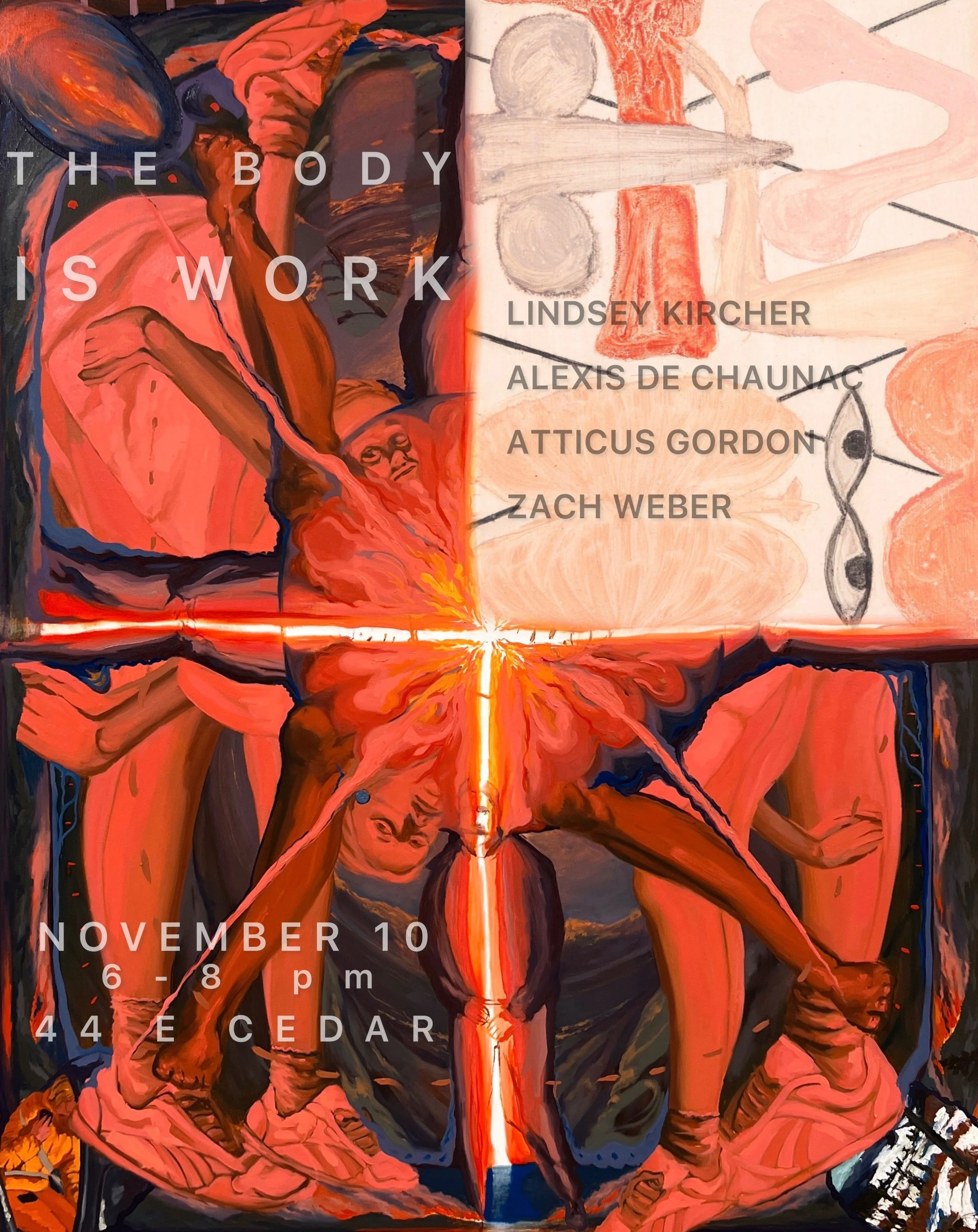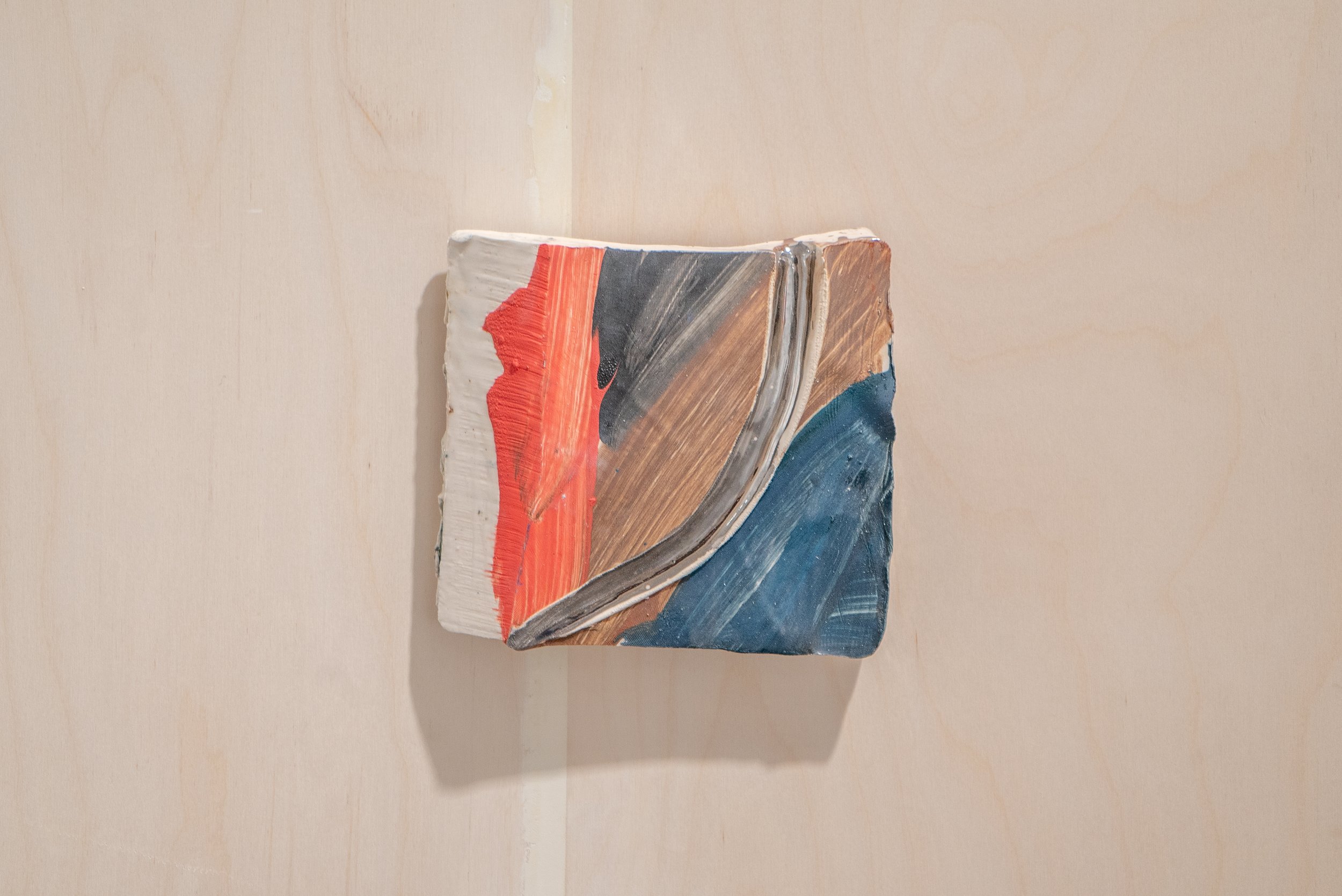
THE BODY IS WORK
Disrupted spaces, forms and bodies built, captivated and born by Lindsey Kircher, Alexis De Chaunac, Atticus Gordon and Zach Weber
Opening reception on November 10th 6-8pm
Visiting hours on November 11th 12-5pm
On view till December 15th by appointment only
STATEMENTS
LINDSEY KIRCHER
Lindsey begins her painting process by sourcing images of Playboy models, professional cheerleaders, Sports Illustrated models, and other images of iconic, ‘conventionally beautiful’ young women from American culture. Her interest in these images comes from a place of conflict. “When I source these materials in my research, I feel a longing to look like these women. I want to possess a beauty that is permanent, unchanging, airbrushed, and flawless. I want to be wanted. But I do not want to be an object of desire, because I do not want to be an object. I resist being valued only for my body, youth, or appearance”.
Painting from these images allows Lindsey to confront her complex relationship to these women and attraction to them. By deconstructing, rearranging, and distorting images of women who are widely accepted as beautiful in American society, Lindsey grapple with her own experiences navigating the freedoms and limitations of beauty. Making these paintings enables her to negotiate the power in expressing her own femininity and sexuality, and the vulnerability of being flattened into an object, consumed for pleasure and entertainment. “As I paint, these women become me, and I become them. I use painting to wrestle with them and with myself, fighting to liberate my body from objectification, while also insisting that I am entitled to celebrate my body and feel desired”.
ALEXIS DE CHAUNAC
Alexis’s transcultural background drives him to create a private mythology where he uncovers the different layers he has embodied. Alexis combines personal memories with the collective human experiences using archetypical imagery such as the Milagros, charm-like metal objects from Mexico, votive sculptural images of body parts, isolated limbs and organs. Milagros were used as magical objects to ward-off disease, pain, and misfortune. They also have metaphorical connotations: a fragmented foot could protect a person undertaking a journey. The forms operate both individually and in communication with one another, creating a hieroglyphic lexicon waiting to be deciphered.
ATTICUS GORDON
Atticus Gordon’s practice revolves around the question of meaning-making in the painting medium. Incorporating new technologies with traditional painting approaches Atticus explores the role of painting as image making in a technologically mediated present. Gordon’s work synthesizes painterly mark making, with digital imaging processes. The imagery in Atticus’ paintings blur and complicate the boundaries between image generation, drawing, animation, and the logic and foundations expressive painting. His works are constellations of ideas, images, and experiences all toying with narrative, symbolism and representation. Atticus often examines the divide between digital and physical life and the flow of images and experience within these two realms. In Atticus’ work the viewer is carefully positioned, some paintings allow the viewer in to see and know, in other paintings sight is obscured or obstructed, while still other paintings present a vision of reality bent out of shape, like a split second of experience beyond the real, magical, frozen in time. The ways of seeing, knowing and experiencing reality, in both physical and digital form, and the process of addressing these questions in paint is the central drive in Atticus’ painting practice.
ZACHARY E. WEBER
Zachary Weber’s work engages with possibilities of aesthetics, tradition, and spatial awareness. Employing a diverse array of materials, techniques and gestures, Weber’s mediated approach to the ceramic process has questioned the boundary of the physical and the two dimensional. In the largest sense, his work takes aim at understanding why we understand what we see.
Born and raised in Chicago, IL, Weber began his creative pursuit at an early age, walking around the city, gleaning materials from sidewalks and utilizing them into his paintings and wall sculptures. They were actions that would later follow him during his developmental forays within mediums. Weber graduated with a merit scholarship from The School of the Art Institute of Chicago (SAIC), BFA (2021).
Living and working in Chicago, IL, Weber draws endless inspiration from the aesthetic, political, and conceptual conditions the city and his studio offers. Constructed out of a spirited and self-mediaded interplay of color, form, and space, his ceramic works (most notably his Seedling series (2022-) represent exchanges of chaos and control in the pursuit of balance and unity. Weber removes and later attempts to integrate pre-existing materials into a more generous sum. His Bouquets series (2022-) are viewed as distilled attempts at finding new spaces to generate awareness. Cutouts from walled vessels, often referencing simple geometries, are reintegrated upwards, carefully negotiated into a visual harmony. “Light acts as a medium by which one can view the surface but also the interior”, Weber explains regarding his practice as a whole. The artist’s Smiley Vase works (2022-) depict gleeful and often tearful expressions spray-painted onto porcelain amphoras.








































